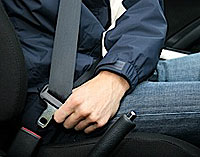

Seatbelts
 The Seatbelt has proven to be by far the most important safety device in cars as it dramatically increases the chances of survival of the occupants in the event of an accident. It has been estimated that seatbelts reduce the risk of death for a front seat car occupant by about 50%. How does the seatbelt work?
The Seatbelt has proven to be by far the most important safety device in cars as it dramatically increases the chances of survival of the occupants in the event of an accident. It has been estimated that seatbelts reduce the risk of death for a front seat car occupant by about 50%. How does the seatbelt work?
Law on Use of Seatbelt :
As per the provisions of sub-rule (3) of Rule 138 of the Central Motor Vehicle Rules, 1989 'in a motor vehicle, in which seat-belts have been provided under sub-rule (1) or sub-rule (1A) of rule 125 or rule 125A, as the case may be, it shall be ensured that the driver, and the person seated in the front seat or the persons occupying front facing rear seats, as the case may be, wear the seat belts while the vehicle is in motion.
Rule 125 (1) requires the manufacturer of every motor vehicle other than motor cycles and three-wheelers of engine capacity not exceeding 500 cc, shall equip every such vehicle with a seat belt for the driver and for the person occupying the front seat.
Rule 125 (1A) requires the manufacturer of every motor vehicle that is used for carriage of passengers and their luggage and comprising no more than 8 seats in addition to the driver's seat, shall equip it with a seat belt for a person occupying the front facing rear seat.
Penal Provisions:
The violation of any of the provisions of rule 138 (3) would constitute an offence punishable under section 177 MVA'88, which reads as follows-
'General provision for punishment of offences-Whoever contravenes any provision of this Act (i.e. MVA'88) or of any rule, regulation or notification made there under shall, if no penalty is provided for the offence be punishable for the first offence, with fine which may extend to one hundred rupees and any second or subsequent offence with fine which may extend to three hundred rupees.'